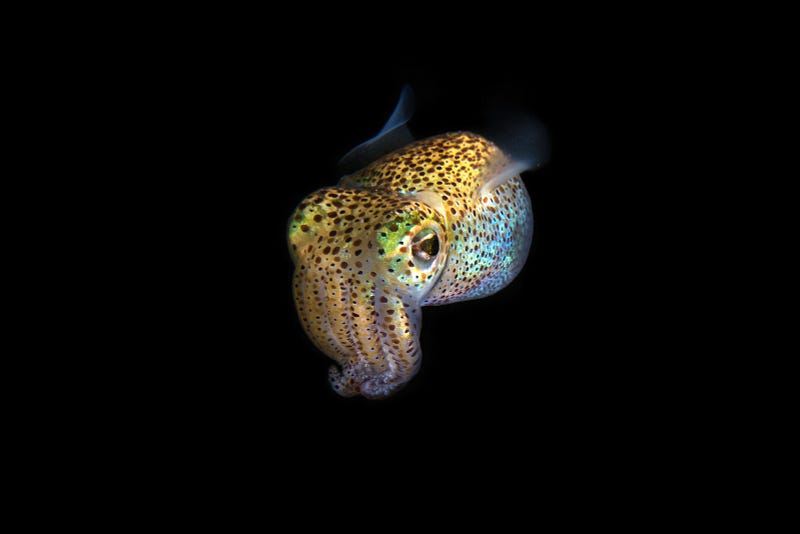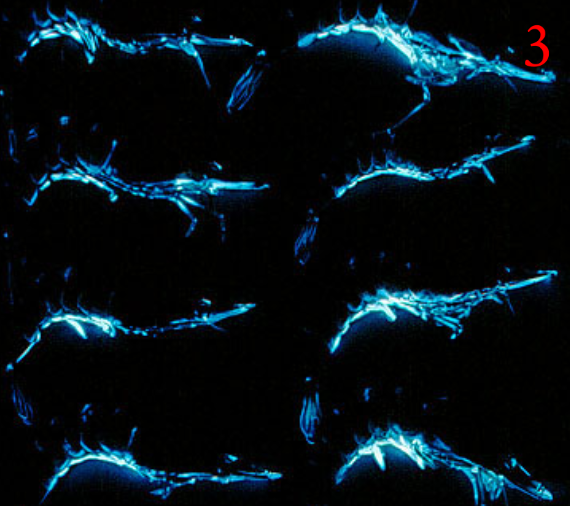
Last week, we looked at krill and their ‘borrowed’ bioluminescence. Of course, they are not the only marine species that gets its glow from another organism. Many glowing marine invertebrates have a symbiotic relationship with bioluminescent bacteria. Many of these belong to a single bacterial genus, Vibrio (though, of course, there are examples outside of this group, and the taxonomic relationships are still being determined).
Vibrio is actually somewhat of a notorious group of bacteria. Typically found in salt or brackish water environments, they are not known by most of the general public for their bioluminescent individuals, but rather their pathogenic ones (bacterial strains that cause disease). The most famous member of the genus is likely Vibrio cholerae, the causal agent for the disease cholera. This bacterium does not glow, but other symbiotic members of the genus do. For example, Vibrio fischeri is one of the more studied symbiotic bioluminescent marine bacteria. It can be found in a number of cephalopod species such as the Hawaiian bobtail squid, Euprymna scolopes, in which it actually inhibits the growth of other potential species of symbiotic competition. In return for nutrients from the squid’s meals, the bioluminescence of the bacteria allow for counter-shading camouflage like that of lanternfish or krill.

Another interesting aspect of the bioluminescent strains of Vibrio bacteria is how they coordinate and regulate the production of their glow. They use a process known as quorum sensing. This is a form of intercellular communication and control based on cell population density. The individual cells are then able to alter their gene regulation and expression of certain traits to maximize the benefit for its current density. While mostly found in bacteria, it can also be observed in some plants and even in social insects like ants and bees. In general, this means that the amount of light production for bioluminescent bacteria (either symbiotic or free-living) is highly dependent on the density of bacterial cells.
Of course, not all bioluminescent bacteria that form symbiotic relationships exhibit a mutualistic pattern (see Season 2 for a more detailed discussion of the different types of symbiosis). For example, Vibrio harveyi is the cause of a debilitating infection in some types of shrimp and prawns (especially those being farmed for human consumption) known as luminous vibriosis. The picture below shows a 5 minute exposure of infected shrimp. As mentioned above, the brightest levels of bioluminescence correspond to higher cell densities. In fact, Vibrio harveyi does not even demonstrate bioluminescence frequently when found in a free-swimming environment. It is only when it infects another organism and cell density increases that quorum sensing switches on the production of the required proteins to exhibit its glow.

Instead of being used for mutual benefit, the bioluminescence seen in these shrimp is a byproduct of their bacterial infection (the infection is systemic, but areas with higher cell density glow brighter). Luminous vibriosis causes necrosis of appendages, frequently ends in death, and is a major concern for shrimp farming in Southeast Asia. Vibrio harveyi is an opportunistic pathogen and will infect a number of potential marine hosts including oysters, crustaceans, and various species of fish.
Only one story left in Season 8 and then Nature Stories will again be taking a short break so that I can prepare for the next season of fascinating stories to share for you. I also have a few other projects in the works that I’ll be focusing on in the interim. As always, please like and share this and if there’s a particular topic you’d like to see me write about in the future please let me know.